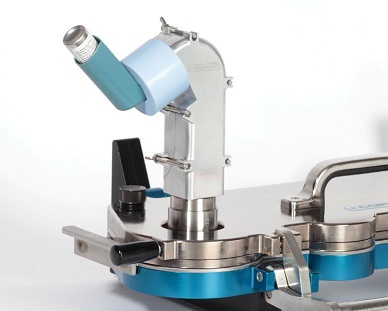Copley Scientific Exhibits Suite of New Inhaler Testing Equipment at RDD 2014

Copley Scientific will exhibit a suite of new equipment launched to meet evolving test requirements for innovator and generic inhaled products at Respiratory Drug Delivery 2014 (RDD 2014, Fajardo, Puerto Rico, 4–8 May).
On display will be the Child Alberta Idealised Throat (AIT), for the representative testing of inhalers for paediatric use, and equipment for testing in accordance with the latest additions to the US Pharmacopeia (USP). This includes the BRS 1100 breathing simulator, for nebulisers and metered dose inhalers with add-on devices, and new accessories for the testing of Fluticasone Propionate Inhalation Powder (FP), a globally used asthma treatment.
The new Second Supplement monograph provides product-specific testing for FP, a common target for generic development. Copley Scientific has introduced the Glass Dose Uniformity Sampling Apparatus (DUSA), FP Induction Port and Pre-separator for use with the Andersen Cascade Impactor (ACI) to meet the requirements of this new monograph and all will be on display at RDD 2014. In combination with the BAC 2000, a timer-controlled solenoid valve, these accessories enable modification of the standard test set-up for inhaler product testing to meet the specifications of the new monograph.
Also on display will be the BRS 1100 and Child AIT. The BRS 1100 is a simple, microprocessor-controlled breathing simulator that generates the breathing profiles for all the patient groups specified by USP and the European Pharmacopoeia for the dose uniformity testing of nebulisers (adult, child, infant and neonate). It similarly enables patient-representative testing of MDIs with spacers and valved holding chambers (VHCs) in accordance with the new draft USP monograph <1602>.
The Child AIT can be used to gather test data that are of direct relevance to paediatric patients. It more accurately simulates the deposition of orally inhaled products in the upper respiratory tract than does the standard USP induction port which is routinely used for APSD measurement. By making testing more representative of in-vivo behaviour, the Child AIT enables more robust demonstration of bioequivalence as well as supporting the advancement of more efficient inhaled technology for paediatric patients.
Related News
-
News Patients vs Pharma – who will the Inflation Reduction Act affect the most?
The Inflation Reduction Act brought in by the Biden administration in 2022 aims to give better and more equitable access to healthcare in the USA. However, pharma companies are now concerned about the other potential costs of such legislation. -
News CPHI Podcast Series: What does the changing US Pharma market mean for industry and patients alike?
In this week's episode of the CPHI Podcast Series Lucy Chard, Digital Editor for CPHI Online is joined by James Manser to discuss the political and market changes in the US pharma field. -
News CPHI Barcelona Annual Report illuminates industry trends for 2024
The CPHI Annual Survey comes into it’s 7th year to report on the predicted trends for 2024. Over 250 pharma executives were asked 35 questions, with their answers informing the industry landscape for the next year, spanning all major pharma marke... -
News Which 10 drugs are open to price negotiation with Medicare in the USA?
The Centres for Medicare & Medicaid Services, under the Biden administration in the USA, has released a list of the 10 drugs that will be open to price negotiations as part of the new legislation under the Inflation Reduction Act (IRA). -
News EU Medical Devices Regulation causes unintended disappearances of medical devices for children, doctors state
Doctor groups and associations have appealed to the EU to correct the EU Medical Devices Regulation law that may cause unintended shortages of essential drug and medical devices for children and rare disease patients. -
News 10 Major Drug Approvals So Far in 2023
Last year, 37 novel drugs were approved by the FDA, this was a high number for such a category, and covered many fields including oncology, demonstrating how promising further research is, and how it is only continuing to build. To date, there are alre... -
News Detecting Alzheimer's disease with a simple lateral flow test
A novel rapid diagnostic test for early-stage Alzheimer's disease has been developed using a biomarker binder from Aptamer Group along with technology from Neuro-Bio, the neurodegenerative disease experts. -
News CPHI Podcast Series: outsourcing and manufacturing trends
Listen to the CPHI Podcast Series this June to hear Gil Roth of the PBOA speak with Digital Editor Lucy Chard about the biggest trends and topics to watch in pharma outsourcing and manufacturing at the minute.
Position your company at the heart of the global Pharma industry with a CPHI Online membership
-
Your products and solutions visible to thousands of visitors within the largest Pharma marketplace
-
Generate high-quality, engaged leads for your business, all year round
-
Promote your business as the industry’s thought-leader by hosting your reports, brochures and videos within your profile
-
Your company’s profile boosted at all participating CPHI events
-
An easy-to-use platform with a detailed dashboard showing your leads and performance







